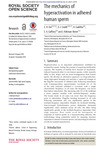Please use this identifier to cite or link to this item:
http://lib.hpu.edu.vn/handle/123456789/22280Full metadata record
| DC Field | Value | Language |
|---|---|---|
| dc.contributor.author | Ooi, E. H. | en_US |
| dc.date.accessioned | 2016-07-18T06:49:09Z | |
| dc.date.available | 2016-07-18T06:49:09Z | |
| dc.date.issued | 2014 | en_US |
| dc.identifier.other | HPU4160437 | en_US |
| dc.identifier.uri | https://lib.hpu.edu.vn/handle/123456789/22280 | en_US |
| dc.description.abstract | Hyperactivation is an important phenomenon exhibited by mammalian sperm during the process of acquiring fertilization capacity. The majority of studies have focused on incubation-induced hyperactivation in non-human species, which typically differ in size, shape, and are more homogeneous than human sperm. We develop an alternative approach via drug-induction, using high-speed imaging and analysis of same-cell changes in the flagellar movement of adhered cells. Following stimulation with 4-aminopyridine, approximately two-thirds (21 of 34) of the cells analysed exhibited a waveform with a single characteristic frequency in all cases, the frequency was lower than before stimulation. | en_US |
| dc.format.extent | 12 p. | en_US |
| dc.format.mimetype | application/pdf | en_US |
| dc.language.iso | en | en_US |
| dc.subject | Bioengineering | en_US |
| dc.subject | Applied | en_US |
| dc.subject | Mathematics | en_US |
| dc.subject | Biomechanics | en_US |
| dc.subject | Spermmotility | en_US |
| dc.subject | Binding | en_US |
| dc.title | The mechanics of hyperactivation in adhered human sperm | en_US |
| dc.type | Article | en_US |
| dc.size | 889KB | en_US |
| dc.department | Education | en_US |
| Appears in Collections: | Education | |
Files in This Item:
| File | Description | Size | Format | |
|---|---|---|---|---|
| 0320_Themechanics.pdf Restricted Access | 889.63 kB | Adobe PDF |  View/Open Request a copy |
Items in DSpace are protected by copyright, with all rights reserved, unless otherwise indicated.
